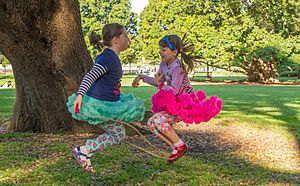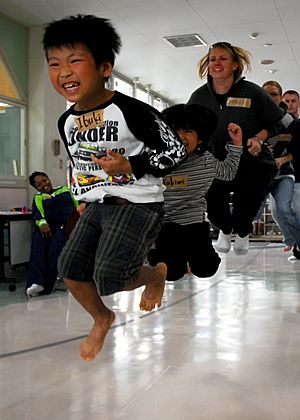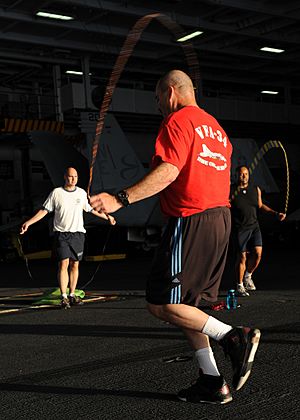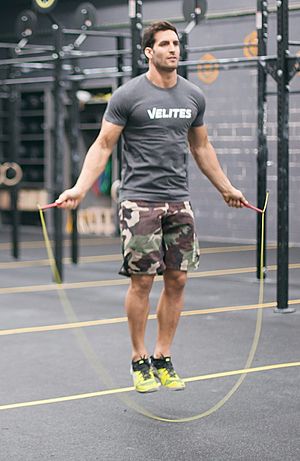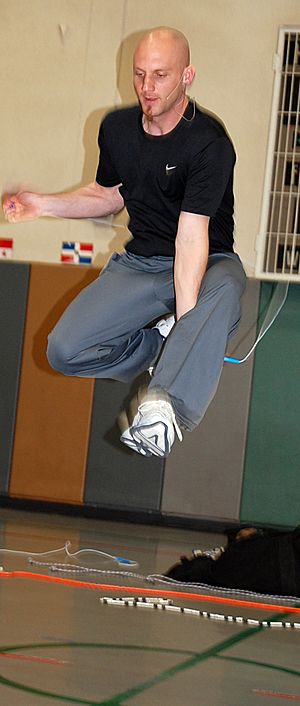Skipping rope facts for kids
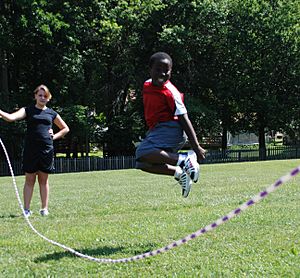
A skipping rope (called a jump rope in America) is a simple tool. It is a rope that people jump over. One or more people can jump over the rope as it swings under their feet and over their heads.
Jump rope is also a sport! It has different types of events. These include:
- Single freestyle: One person performs tricks.
- Single speed: One person jumps as fast as possible.
- Pairs: Two people jump together.
- Three person speed (Double Dutch): Two people swing two ropes in opposite directions, and one person jumps.
- Three person freestyle (Double Dutch freestyle): Two people swing two ropes, and one person performs tricks.
Competitions often separate jumpers by their gender and age. There are many competitive jump rope teams all over the world.
A few big groups support jump rope as a sport. Schools usually do not have jump rope teams. Also, states do not officially approve jump rope events for high school or elementary school.
In freestyle events, jumpers show off many basic and advanced moves. They do this in a one-minute routine. Judges score their routine based on content and performance. In speed events, a jumper jumps by alternating their feet. The rope goes around them each time one foot touches the ground. This lasts for 30 seconds, one minute, or three minutes. Judges count how many times the right foot touches the ground.
Children often play games with skipping ropes. These games can include fun skipping rope rhymes.
Contents
- Skipping Rope Moves and Techniques
- Moves for One Jumper
- Basic Jump: Easy Way to Start
- Alternate Foot Jump: For Speed
- Criss-Cross: Crossing Your Arms
- Side Swing: Rope Beside You
- EB (Front-Back Cross): A Tricky Cross
- Double Under: Two Turns Per Jump
- Toad: Arm Under Leg
- Leg Over / Crougar: Arm Hooked
- Awesome Annie: A Smooth Combo
- Inverse Toad: Another Arm Under Leg
- Elephant: Both Arms Under One Leg
- Frog or Donkey Kick: Upside Down Jump
- The James Hirst: An Amazing Flip
- Competition Techniques: Showing Your Skills
- Moves for One Jumper
- Health Benefits of Skipping
- Images for kids
- See also
Skipping Rope Moves and Techniques
There are many different ways to jump rope. You can use these moves on their own. Or, you can combine them to create a cool routine.
Moves for One Jumper
Basic Jump: Easy Way to Start
For this jump, you jump with both feet slightly apart over the rope. Most beginners learn this move first. Then, they move on to harder techniques.
Alternate Foot Jump: For Speed
With this move, you jump off the ground using one foot, then the other. This technique can help you jump much faster. It is often used in speed events.
Criss-Cross: Crossing Your Arms
This move is also called Crossover or cross arms. You do the basic jump, but you cross your arms in front of your body.
Side Swing: Rope Beside You
The rope swings past your side. You do not jump over it.
EB (Front-Back Cross): A Tricky Cross
You do the criss-cross, but one arm crosses behind your back.
Double Under: Two Turns Per Jump
This is a high basic jump. You turn the rope twice under your feet before you land. Turning the rope three times is called a triple under. In competitions, jumpers might even try four (quads) or five (quins) turns!
Toad: Arm Under Leg
You do the criss-cross, but one arm crosses under the opposite leg from the inside.
Leg Over / Crougar: Arm Hooked
This is a basic jump where one arm hooks under the leg next to it.
Awesome Annie: A Smooth Combo
This move is also known as Awesome Anna or swish. You switch between a leg over and a toad without an extra jump in between.
Inverse Toad: Another Arm Under Leg
You do the toad, but one arm crosses the leg next to it from the outside.
Elephant: Both Arms Under One Leg
This move is a mix of the inverse toad and the toad. Both arms cross under one leg.
Frog or Donkey Kick: Upside Down Jump
The jumper does a handstand. Then, they return to their feet and turn the rope under them. A harder version turns the rope while they are returning to the ground.
The James Hirst: An Amazing Flip
The jumper does a backflip into a split. Then, they flip back up to an upright skipping position.
Competition Techniques: Showing Your Skills
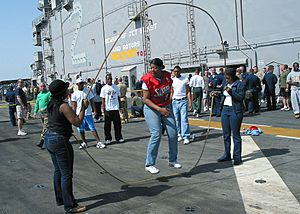
In jump rope competitions, jumpers must show they can do specific moves well. The exact moves needed depend on the judging rules and the country where the competition is held.
Health Benefits of Skipping
Skipping as Exercise: A Great Workout
Skipping is a great way to get a cardiovascular workout. This means it helps your heart and lungs. It is similar to jogging or riding a bicycle. This type of exercise is called aerobic exercise.
Skipping can burn a lot of calories. You can burn from 700 to over 1000 calories in an hour of hard skipping. About 0.1 to almost 1.1 calories are used per jump. This depends on how fast and hard you jump. Ten minutes of skipping is like running a mile in eight minutes. Skipping for 15 to 20 minutes can burn off the calories from a candy bar. This is like running for 45 to 60 minutes, depending on how hard you jump.
Many fitness experts and professional fighters suggest skipping for burning fat. They often say it is better than other exercises like running.
You can also find weighted skipping ropes. These ropes are heavier. They make the exercise harder and even more effective. One person or a group can skip together. Learning how to skip properly is fairly easy compared to many other sports. Skipping is also good for people of all ages and fitness levels.
Images for kids
See also
 In Spanish: Salto a la cuerda para niños
In Spanish: Salto a la cuerda para niños


